Indonesian Traditional Cookies for Festivities Posted by asimonoff on Dec 29, 2016 in Uncategorized
Festivities are not complete without the must-have, scrumptious, mouthwatering cookies that are always present in Indonesian households. ‘Kue kering,’ or dried cookie, is Indonesian for a cookie. Kue is a relatively broad term used in Indonesia for a wide range of pastries, from ‘kue kering’ (dry cookie) cookies to biscuits, scones, pies, ‘kue basah’ (wet cake) cakes, and tarts. Those traditional cookies are Kue Nastar (pineapple jam filled cookies), Kastengels from Dutch Kaastengels (Cheese Stick cookie), Kue Putri Salju (Snow White cookies), Kue Keju sagu (Sago Cheese Cookies), Kue Lidah Kucing (Cat’s Tongue Cookie), and Kue Spekulas Kenari (Speculaas Almond).
The tradition of eating bread and pastries was brought by the Europeans, mainly Dutch, to Indonesia during the Dutch colonization of Indonesia. It is no surprise that, eventually, it became an Indonesian tradition. Therefore, you will find most of the Indonesian festivities’ baked pastries and techniques coincide with the Europeans’. However, even though the basic ingredients are the same, some recipes have been modified from its original Dutch to meet the changing taste of the people.
Nastar (Pineapple jam filled cookies)
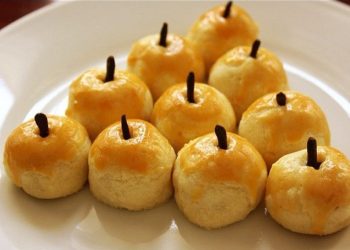
Image by Revin2008/Flickr/all creative commons
Nastar is the most popular cookie in Indonesia. It is originally a Dutch recipe for “Tart Ananas.” It makes 2- or 3-cm round shapes with pineapple jam filling, and often, it is garnished with whole cloves on top. Its buttery and tangy-sweet homemade pineapple jam filling will tease your taste buds for more. You will want to eat five pieces of Nastar to satisfy yourself.
Kastengels (Cheese stick cookies)
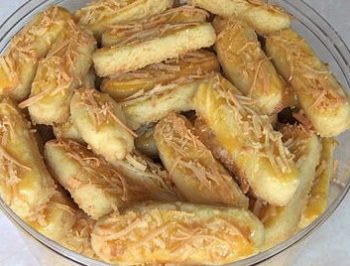
image: wikimedia creative commons
This little delight savory cookie is called kaastengels in Dutch and kastengel or kue keju in Indonesian. It is an Indonesian cheese stick cookie. Kastengel is savory, buttery, cheesy, and irresistibly delicious. It is often made with either cheddar or gouda cheese. Depending on your preferences, it can be made crunchy or crumbly by adding more cheese or butter, or it can be made softer. Brush it with an egg, add more cheese, and make it even tastier by sprinkling shredded cheese on top.
Kue Putri Salju (Snow white cookies)
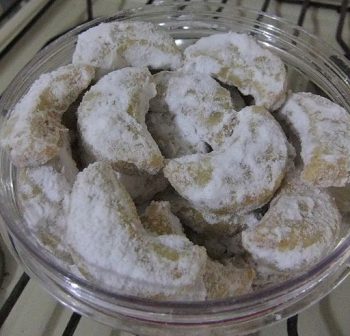
image: wikimedia creative commons
Kue putri salju or “snow white” is autter crescent-shaped cookie with sliced thin almonds on top. Putri salju comes from the thick coating of powdered sugar on top of it.
Kue Keju Sagu (Sago cheese cookies)
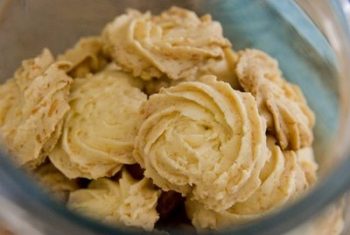
image: dapur masak azumku.com
Sago cheese spritz cookies are known for their beautiful shapes as you have more freedom to create any shape you like. Its unique texture, softness, and crunchiness will melt in your mouth. It is very delicious.
Kue Lidah Kucing (Cat’s tongue cookie)
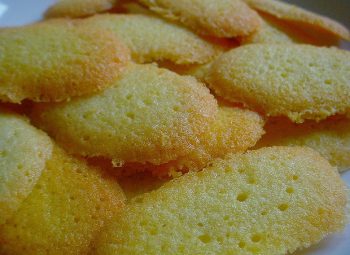
image: Nugrahaini/Flickr/all creative commons
This sweet, crunchy, and light fingerling cookie was originally from the Netherlands. Its thin, long, and “tongue-like” shape earned it the name ‘Kue Lidah Kucing’ or cat’s tongue. In Dutch, it is called, Kattetong. Sometimes, part of it is covered in chocolate to give you more sensational tastes.
Kue Kering Spekulas Kenari (Speculaas almond)
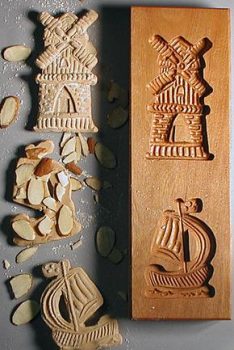
Image: Pixadoodles Pixadoodles/Flickr/all creative commons
Kue kering spekulas or speculaas was introduced by the Dutch and has been adopted by Indonesians as one of their specialty cookies. It is usually served during Christmas. It is one of the favorites for its unique flavor and aroma that is rich in spices such as cardamom, cinnamon, cloves, ginger, and nutmeg, added with thinly sliced almonds that make the cookie tastier. Children love the cookie as it is made with various shapes: windmill, classic St. Nicolas, clown, and other Indonesian characters.
Related vocabulary – Kosa kata
| Kue kering – cookie |
| Kue basah – cake |
| Rasa coklat – chocolate flavor |
| Kacang – peanut |
| Kacang kenari – almond |
| Telur – egg |
| Tepung gula – powdered sugar, confectioner sugar |
| Gula pasir – granulated sugar |
| Tepung – flour; tepung terigu – wheat flour |
| Ditaburi – sprinkled |
| Keju – cheese |
| Sagu – sago |
| Bumbu – seasoning |
| Rempah-rempah – spices |
Questions:
- Have you eaten one of the above cookies? What do you think?
- Have you baked any of the above cookies? What do you do differently when you make it?
- Do you find any similar cookies in your country?
- What are the specialty cookies from your country?

Build vocabulary, practice pronunciation, and more with Transparent Language Online. Available anytime, anywhere, on any device.
About the Author: asimonoff
I’m an Indonesian language instructor, instructional material developer, reading test developer, and interpreter. I have been teaching Indonesian to adult students for 15 years, and have been teaching students from many backgrounds, such as private, military and diplomatic service employees. I’m Indonesian, but am living in the US now; my exposure to different cultures in my home country and in the US has enriched my knowledge in teaching Indonesian as a second language. I approach the teaching of the Indonesian language by developing students’ critical cultural awareness and competence. This method of teaching has been proven to be a key to the success of my students. Students become conscious of the essential role culture plays in the language.



